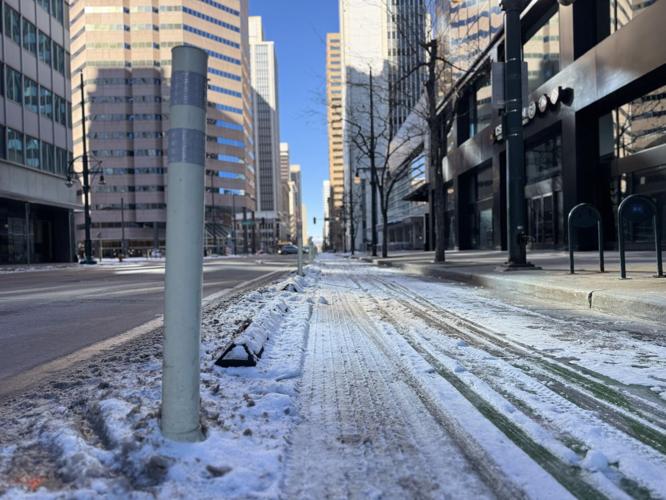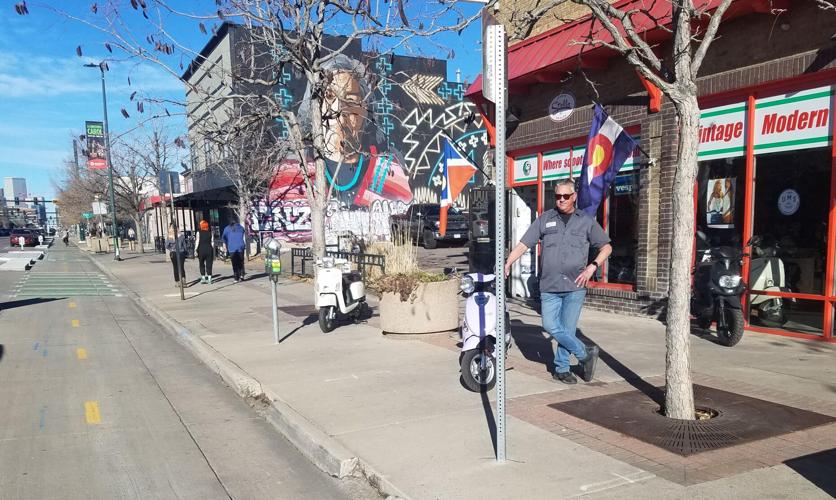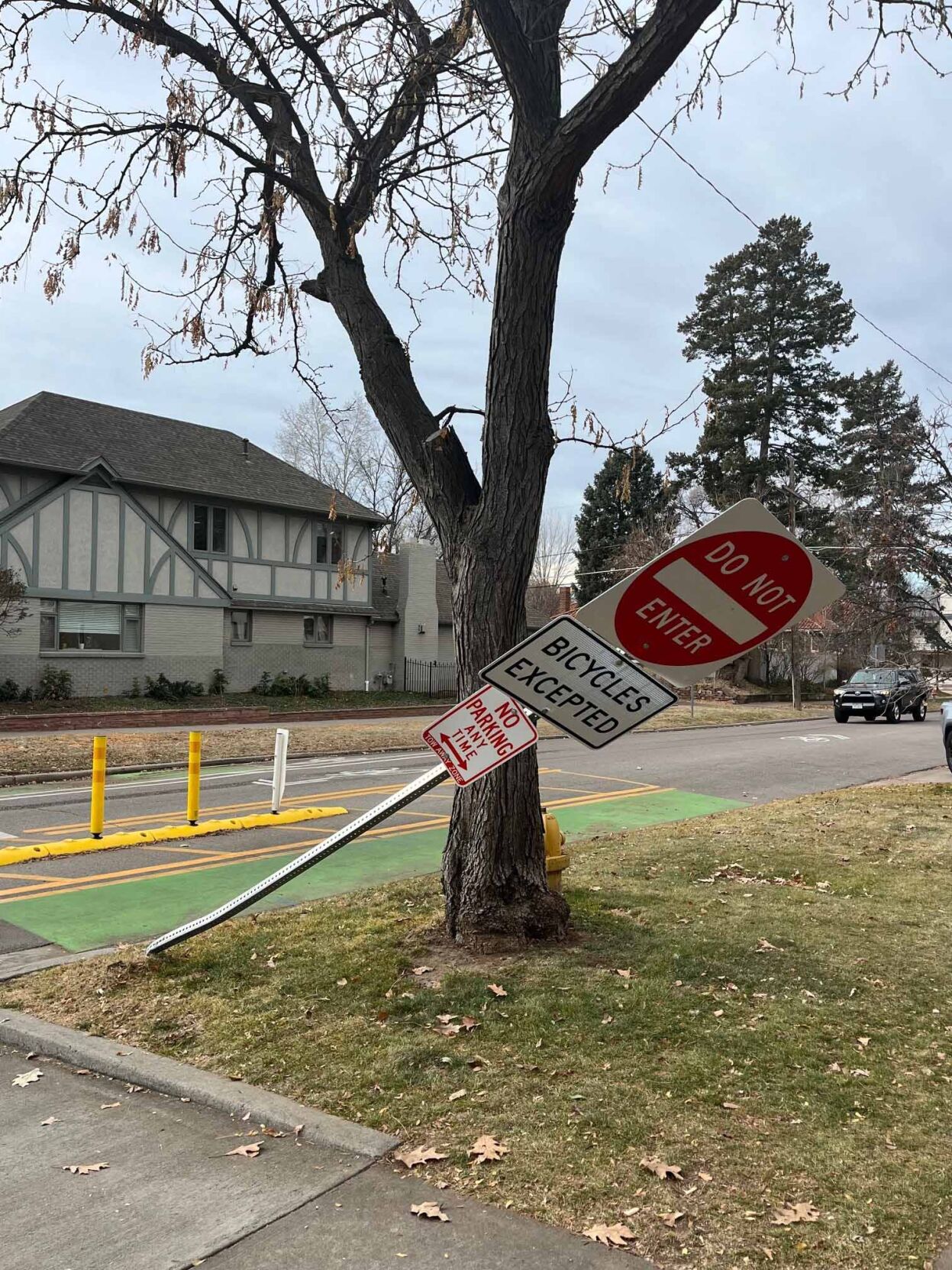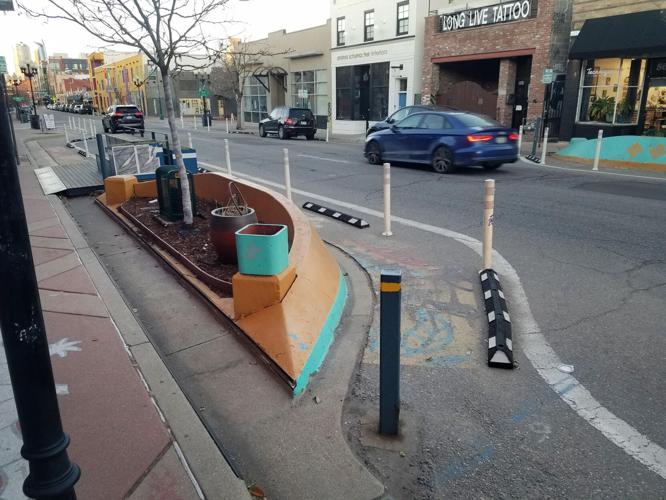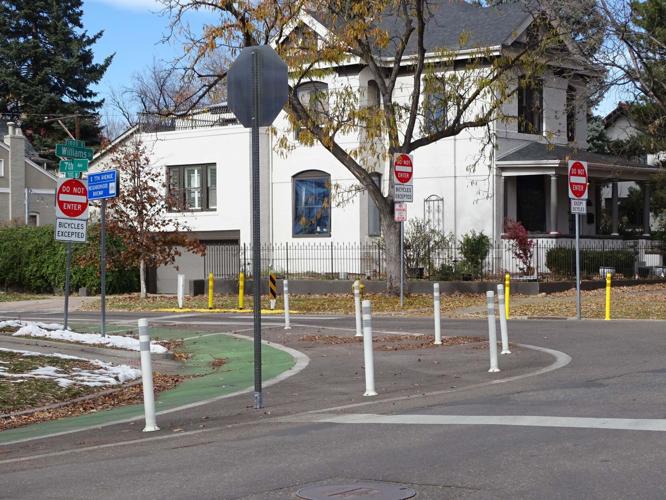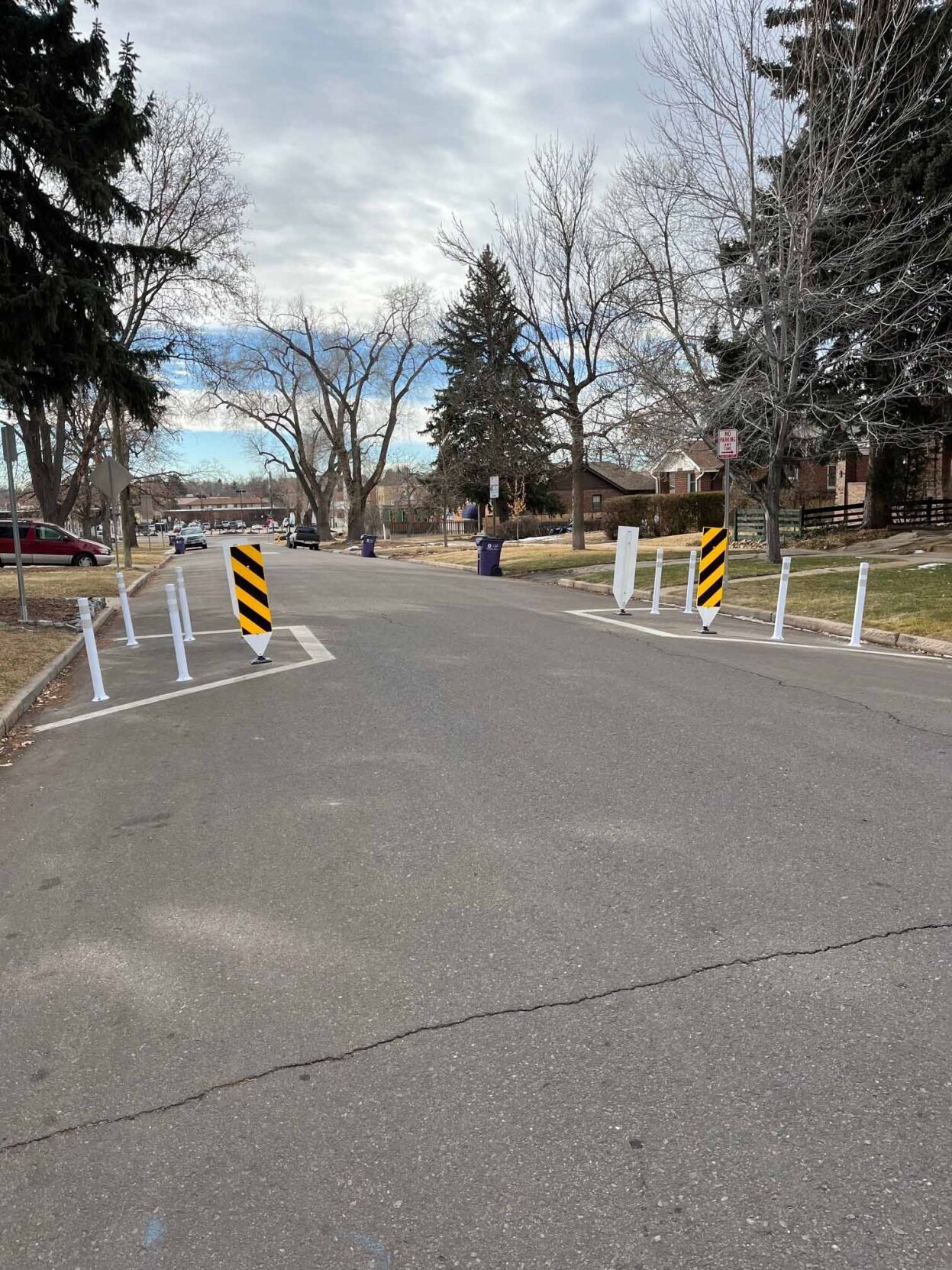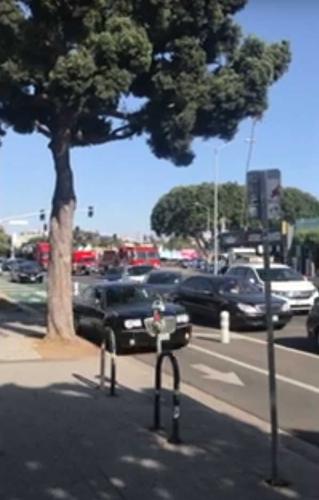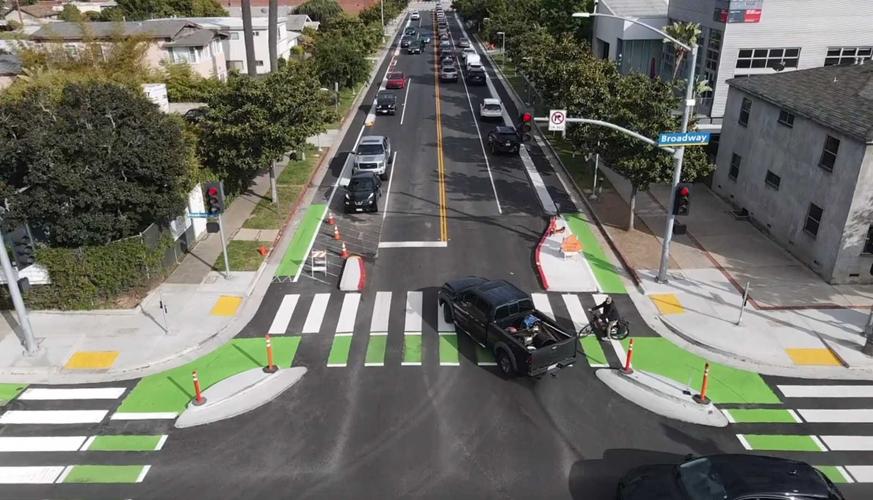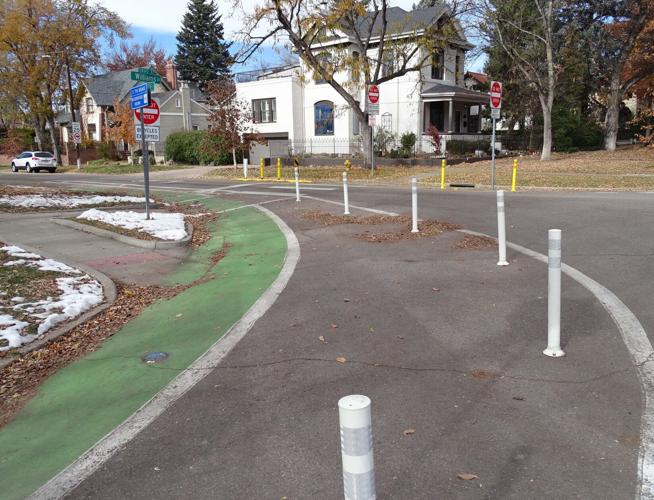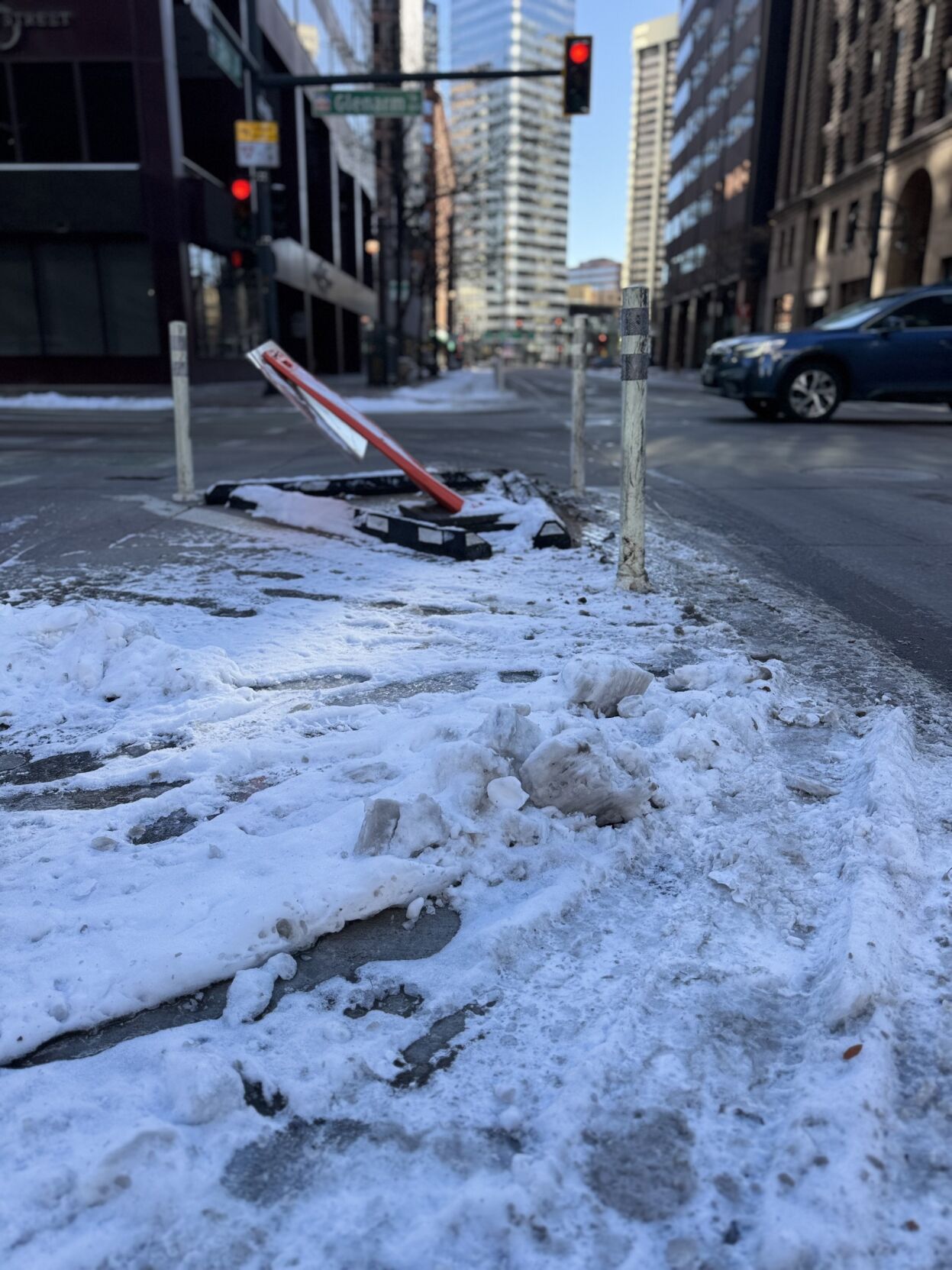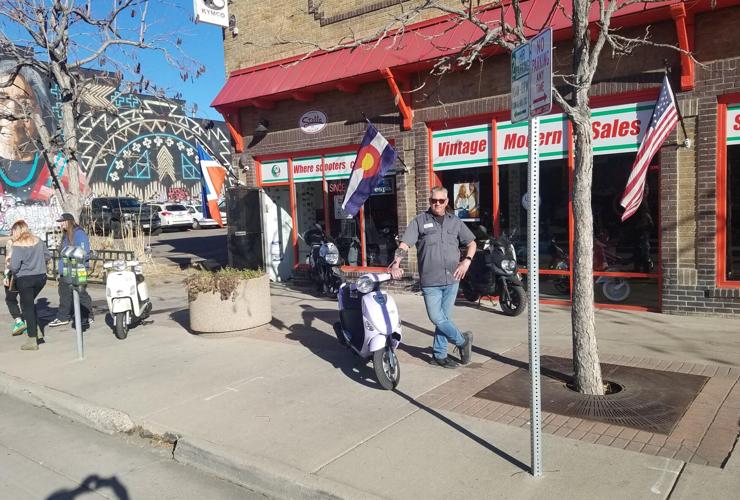Are Denver’s ‘protected’ bike lanes safe?
New bikeways have substantially transformed the look of some of the corridors with the highest traffic around downtown Denver and are now creeping into neighborhoods, where residents complain about the optics of the signs and bollards.
City officials and bike advocates insisted those bikeways are critical to reducing accidents on city streets.
But are they actually making streets safer?
That’s a question that critics are asking in Los Angeles, a city like Denver that largely evolved around the automobile and that is now aggressively promoting bikeways as a remedy for traffic deaths.
One California-based group said traffic fatality data, particularly pedestrians, form a hockey stick graph over the past decade as new bike infrastructure popped up on L.A.’s streets.
Opponents of bikeways said that few factors other than bollards and bikeways can account for the jump.
Citing video evidence, those critics said protected bikeways — areas separated by some kind of a physical barrier, such as a bollard — also slow response times of emergency services, something that took on gravity last month as fires took lives and thousands of homes in Los Angeles County. Videos captured during a previous fire show how bollards and bump-outs can clog traffic during emergencies, as when residents are evacuating homes.
Meanwhile, bikeways are popping up across the country — getting a boost from $13 billion in federal dollars for biking and walking projects earmarked as part of the Biden administration’s $1.2 trillion Infrastructure Investment and Jobs Act, which Congress passed in 2021.
Advocates for bike projects quote a 2019 study of 12 major U.S. cities saying areas with dedicated bike lanes posted 44% fewer deaths and 50% fewer serious injuries than average cities. That study underscores a factor that officials in Colorado cite in support of bikeways — that higher speeds make accidents more frequent and deadly, and that bike infrastructures tend to slow traffic down.
But opponents here and elsewhere are now questioning how bikeways actually perform in reducing traffic crashes.
‘We have data that shows it’s working’
After The Denver Gazette ran a story about an east Denver neighborhood fighting back against bike lane protections headed for their quiet streets, the city’s Department of Transportation and Infrastructure wrote to emphasize that bikeways are foremost about safety.
“People continue to lose their lives on Denver roadways at an alarming rate each year,” a DOTI spokesperson said in the letter to The Denver Gazette. “We are working to reduce fatal and serious injury crashes by slowing drivers down using a variety of methods, including bollards, traffic circles, center medians, signage and more.
“We have data that shows it’s working.”
DOTI provided The Denver Gazette with data regarding two sections of protected bikeways that have drawn strident complaints from neighbors: East Yale Avenue in University Park, and through the city’s East 7th Avenue Historic District.
DOTI has also carried out a “user perception survey” along one bikeway inquiring how safe or comfortable people feel walking, bicycling, or scooting on the street.” DOTI reported that 55% of respondents replied they felt either very or mostly safe and comfortable.
DOTI stressed that no fatal or serious bodily injury crashes had taken place from last year after both bikeway sections were installed.
“That’s bull****,” East 7th Avenue resident Mark Turnage told The Denver Gazette earlier this month.
Turnage, who said he frequently writes DOTI, the Denver City Council and Councilmember Amanda Sawyer about the new infrastructure, claimed he personally witnessed accidents and close calls over the past year — after the installation.
A cyclist himself, Turnage said he won’t let his kids bike along Seventh. He complained that neither Sawyer nor city officials directly responded to his queries.
Among the complaints of 7th Avenue neighbors were the “corner extenders” made from bollards that seem to force bikes and cars into the same tight space. They also pointed to the three roundabouts that DOTI installed, where neighbors report near-misses involving cross traffic that is no longer controlled by stop signs.
The residents’ accident diary
Data from the city’s real-time tracking website shows 52 crashes along East 7th from Sherman Street east to York Street over the past decade, including a fatality in early 2023 and two bike-related accidents — neither of them recent.
In the 20 months since improvements were installed, tracking shows seven crashes, a slightly higher-than-average percentage for the span.
At East 7th and Williams Street, DOTI has installed “Do-Not-Enter/Bicycles Excepted” signs that close the block to westbound cars. More signs, painted lanes, and a cacophony of 50 bollards crowd the intersection.
Even a year after installation, drivers appeared bewildered by the array — one was weaving between possible exits through the lanes; another was opting to drive the wrong way through the Do Not Enter signs.
One sign lay bent over the sidewalk, apparently the victim of a car collision. The sign was reportedly replaced last month; however, a sign on the opposite corner also appears to have been hit by a vehicle.
Following queries from The Denver Gazette, DOTI provided updated data showing serious accidents down citywide last year — those involving serious injury were off by 5% in 2024 over 2023, and fatalities were down 8%.
An important context: Denver’s Vision Zero dashboard shows 2023 as a high-water mark for crashes over the longer term, with serious injury crashes up 31% over the past 10 years, and fatalities up 43%. The dashboard currently shows as taken down for maintenance.
Seventh Avenue neighbors kept their own accident diary during the first months after the improvements were installed that don’t appear to be reflected in the city’s own reporting.
Those included one on June 29, 2023, right after the bollards arrived, when a woman trying to cycle along what residents call a “wild mouse” turn in the bollard-lined bikeway took a fall, requiring an ER visit and a reported surgery.
On Aug. 8, 2023, the diary continued, a biker fell into the street after a car ran the do-not-enter sign. On Aug. 21, two cars collided at a roundabout at Gilpin Street. On Aug. 28 a vehicle crashed at a roundabout; on Sept. 24, a car hit two parked cars near a roundabout; on Sept. 26, the fire department responded to a cyclist accident; on Oct. 7, passengers were injured at Emerson; and on Jan. 28, 2024, a vehicle lost control at a roundabout, reportedly with serious injuries.
The Denver Gazette cannot independently verify the accuracy of neighbors’ traffic crash tracking.
While the neighbors are pushing back, cyclist advocacy groups are largely behind the expanding network.
“It’s a work in progress,” Jill Locantore, executive director of Denver Streets Partnership, told The Denver Gazette.
“The city has solid plans for making transportation system work better, creating options for other than driving,” she said.
Improvements, she added, seek to address what she calls an “epidemic of traffic violence.”
“Streets are dangerous by design, designed to allow cars to go as fast as possible,” Locantore said. “Traffic fatalities are one of the leading causes of preventable death, and street design is a major cause. The city is doing the right thing in changing the curve.”
A European experiment in America
Meanwhile, neighbors questioned whether there is actually enough bicycle traffic using new bikeways to justify the effort.
That question applies, they said, not just in quiet neighborhoods around downtown, but also along busily trafficked South Broadway, where a new bikeway has reduced available parking for stores and restaurants.
“You can just look at the bike lane on a 61-degree day. I don’t see any bicycles,” said Colin Shattuck as he stood out front of his Sportique Scooters, where the two-lane bikeway passes steps from his door.
“I like to say that (the bikeway is) a nice place to stand if you don’t want to be hit by a bike,” Shattuck quipped to The Gazette, on an un-seasonally warm Saturday afternoon last month.
“I’ve watched this evolve since they first cut down the eight parking meters that were along this stretch,” Shattuck said, pointing along his block between Maple and Cedar Avenues, where the bikeway runs.
The improvement looks like a bike highway with opposing lanes facing each other. It is separated from Broadway’s busy traffic by a few remaining parking spaces that lie further out in the boulevard. To pay the meter, parkers have to step carefully over the bikeway to reach the sidewalk.
Bikeways here and in other cities, Shattuck noted, are designed in support of Vision Zero, a global movement to eliminate traffic fatalities that was launched in 1995 by Swedish traffic safety director Claes Tingvall.
The city’s transportation department broadly references Vision Zero in its advisories in support of its “Denver Moves: Bikes” masterplan, which envisions 230 miles of paths that would one day put one within a quarter mile of every Denver home.
In European cities like Stockholm, Vision Zero has a three-decade record of success in decreasing serious traffic crashes, backers said.
But the model’s success in the U.S. is more clouded, said Christopher LeGras, co-director of the California-based KeepLAMoving — a non-governmental organization focused on safer mobility.
“I can’t tell you why it has worked in Europe, but trying to apply it to American roadways has been a disaster,” LeGras told The Denver Gazette.
L.A., already with 700 miles of bike lanes and another 19 miles of protected bikeway, is now on track to slim down famous Hollywood Boulevard from four lanes of traffic to two to allow for protected bikeways.
‘An illusion of safety’
Bikeway advocates called these traffic slimming strategies “road diets.” But now they’re running into headwinds from groups like LeGras’s not just for the slower flow but also on whether they actually reduce crashes and injuries at all.
U.S. traffic deaths peaked at around 55,000 deaths in 1972, when cars didn’t have airbags, LeGras said. Traffic deaths fell to a record low of 32,700 deaths in 2011, but then ratcheted up, topping out in 2021 at 43,200 deaths according to the National Highway Traffic Safety Administration.
“The safest year on U.S. roads was 2011 or 2012, at the exact moment when politicians announced Vision Zero,” said LeGras. “In 2014, (the rate) really took off, and last year we were almost back to where we were in early ‘70s.”
LeGras said he suspects that road diets are a reason rates have jumped.
In Los Angeles, a warning bell sounded in 2018, when the city published its first Vision Zero progress report, showing a sharp uptick in pedestrian deaths — from 74 in 2015 to 135 in 2017 as the new vision was adopted.
That followed two decades in which traffic deaths averaged 84 per year. LeGras said the only variable was Vision Zero.
The Los Angeles organization SAFE (Streets Are For Everyone), which tracks its own data, reported L.A. had 336 traffic fatalities in 2023, the highest in decades, an 8% increase from 2022, and up a staggering 81% from 2015, when Vision Zero launched.
Most disturbing, according to SAFE data, is that 179 deaths were pedestrians and 24 were cyclists — totals that are up dramatically from 10 years ago.
“We speculate the reason why is a new kind of distracted driving,” said KeepLAMoving’s LeGras. “When you get to an intersection, that’s where these accidents tend to increase, with bollards, parked cars, confusing lane striping, signs, zebra-striped crosswalks.”
“As you’re driving your car, the last thing you’ll see is that cyclist,” he said.
Colin Shattuck said he sees that effect on Denver’s South Broadway.
“If I’m on Maple headed westbound and turn south onto Broadway, I cannot see if cars are coming. All I can do is slowly creep forward, blocking the bicycle lanes and the sidewalk. Bicyclists are shaking their fists at me.”
He insisted he sees more incidents and accidents since the infrastructure went in.
“I have seen a guy on a bicycle get absolutely creamed after a car made a left turn,” he said.
Denver Streets Partnership’s Jill Locantore, who bikes both Broadway and the quieter sections of bikeway, insisted that bikeways space are an improvement.
“The bigger streets carry a higher volume of traffic, where you have vertical separation from bike lanes and everyone can be in their own space. Then you have neighborhood local streets where you don’t need that level of separation, but if you can lower the speed you can make it safer for everyone.”
The vision of major bikeways, such as Broadway’s, she said, will become clearer as future sections are completed.
“It’s now much safer with the designated space, but it doesn’t yet connect to a network,” she said.
Some observers question whether protected lanes give cyclists an unwarranted feeling of complacency as they maneuver close to cars and trucks.
“Bikers tend to use bike lanes as an excuse not to follow traffic rules,” said Mark Turnage. “I walk the dogs on Seventh every night and both cars and bikes fly by without slowing down.”
Recently he witnessed a near car-bike collision at Seventh and Downing.
“Because it’s protected it creates an illusion of safety that isn’t there,” added Shattuck.
“I don’t see that,” said Nicole McSpirit, a former “Bike Mayor” on behalf of the Denver Bicycle Lobby. McSpirit said she cycles for 95% of her travel and works to help inexperienced riders become comfortable on their bikes.
That said, she added, “I can’t tell you how many close calls I’ve had.”
Even on slower streets in her Park Hill neighborhood, she sees close encounters resulting from drivers failing to watch for bikers and from illegally parked cars near intersections that reduce visibility.
Regarding the improvements drawing the sharpest criticism — the vertical “chicanes” and “pinch points” that force traffic to slow — McSpirit said those are necessary evils on the route to a more permanent infrastructure.
“Those are not my favorite,” she said, adding that she tends to avoid paint-only bikeways with no vertical separation, or chooses backstreets with no improvements.
The vertical devices, McSpirit said, are a quick fix to increase visibility, while budget for such projects is limited.
“It’s easier to tweak a design when we have funding for a more permanent infrastructure,” she said.
‘Can firefighters remove these?’
Meanwhile, KeepLAMoving’s web site shows previous video footage documenting how road-diet infrastructure seemingly slows the response time of emergency vehicles. The footage shows firetrucks and ambulances crawling down a crowded boulevard squeezed by protected bikeways, with cars unable to clear the way.
One portion shows footage from the 2018 Camp Fire that claimed 85 lives in Butte County, Calif. In the town of Paradise, where most deaths occurred, traffic evacuating the city is shown crawling along a highway narrowed to two lanes as a road diet measure.
Do Denver firefighters worry about how their response might be slowed by bollards during an emergency?
Contacted while fires were consuming homes in Los Angeles County, Denver Assistant Fire Chief Carly Helwick told The Denver Gazette that although city agencies work to cooperate, the fire department has issues with the infrastructure.
“They want more bikeways and that’s always understandable,” the assistant chief said. “But we communicate to DOTI that anytime we’re putting in bollards, we’re looking and asking: Can firefighters remove these?”
“We’ve seen what makes it through planning, and they don’t have an eye for that as first responders do,” he said. “It’s a huge challenge to stay ahead so that we can operate quickly, and it’s counterintuitive to what they’re trying to achieve.”
Meanwhile, neighbors along East 7th said the safety situation worsens in winter weather, as roundabouts add difficulties for snowplows needing to remove snowmelt and ice.
“It’s taken a bad situation and made it worse,” said Sarita Krishnamurthy, who lives near a new roundabout on Seventh west of Downing, where she sees a few crashes and numerous near-misses, including a bike skidding on ice, narrowly missing a car.
“Now, with no stop signs, cars don’t pay attention to pedestrians. They don’t even look to slow down,” she said. “Roundabouts aren’t effective in slowing people down. I’m not sure why they’re not listening to residents who live their lives on Seventh.”





